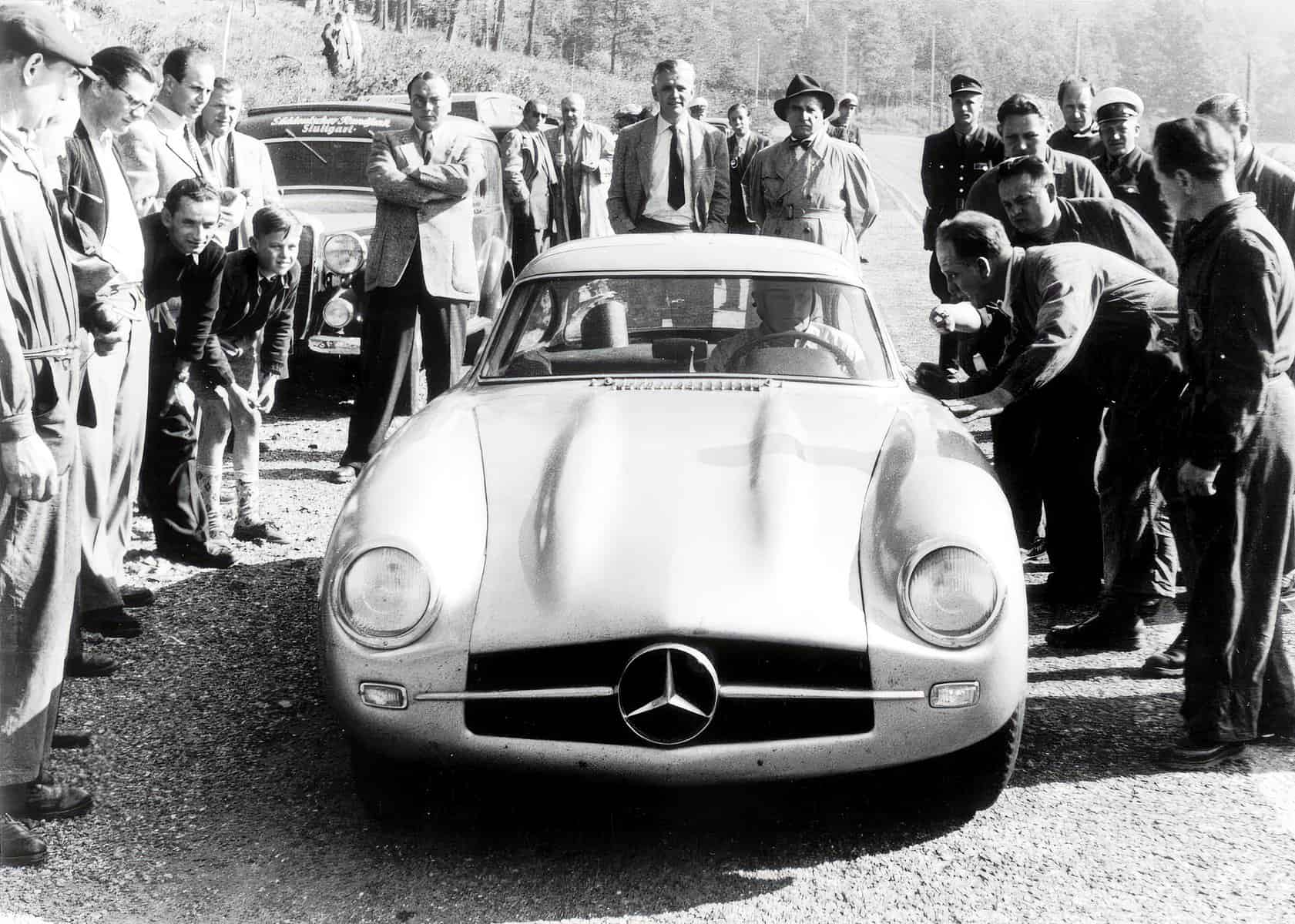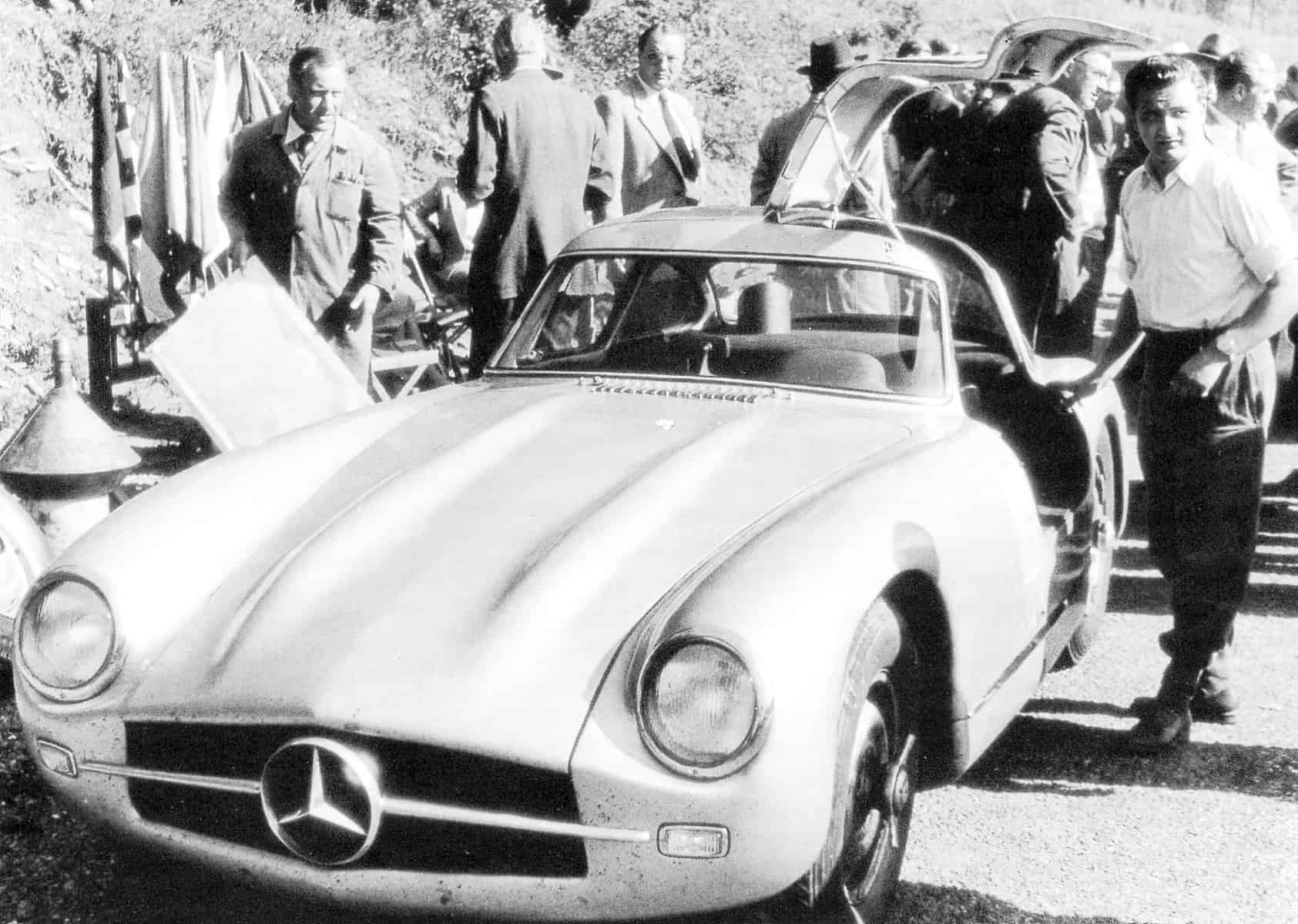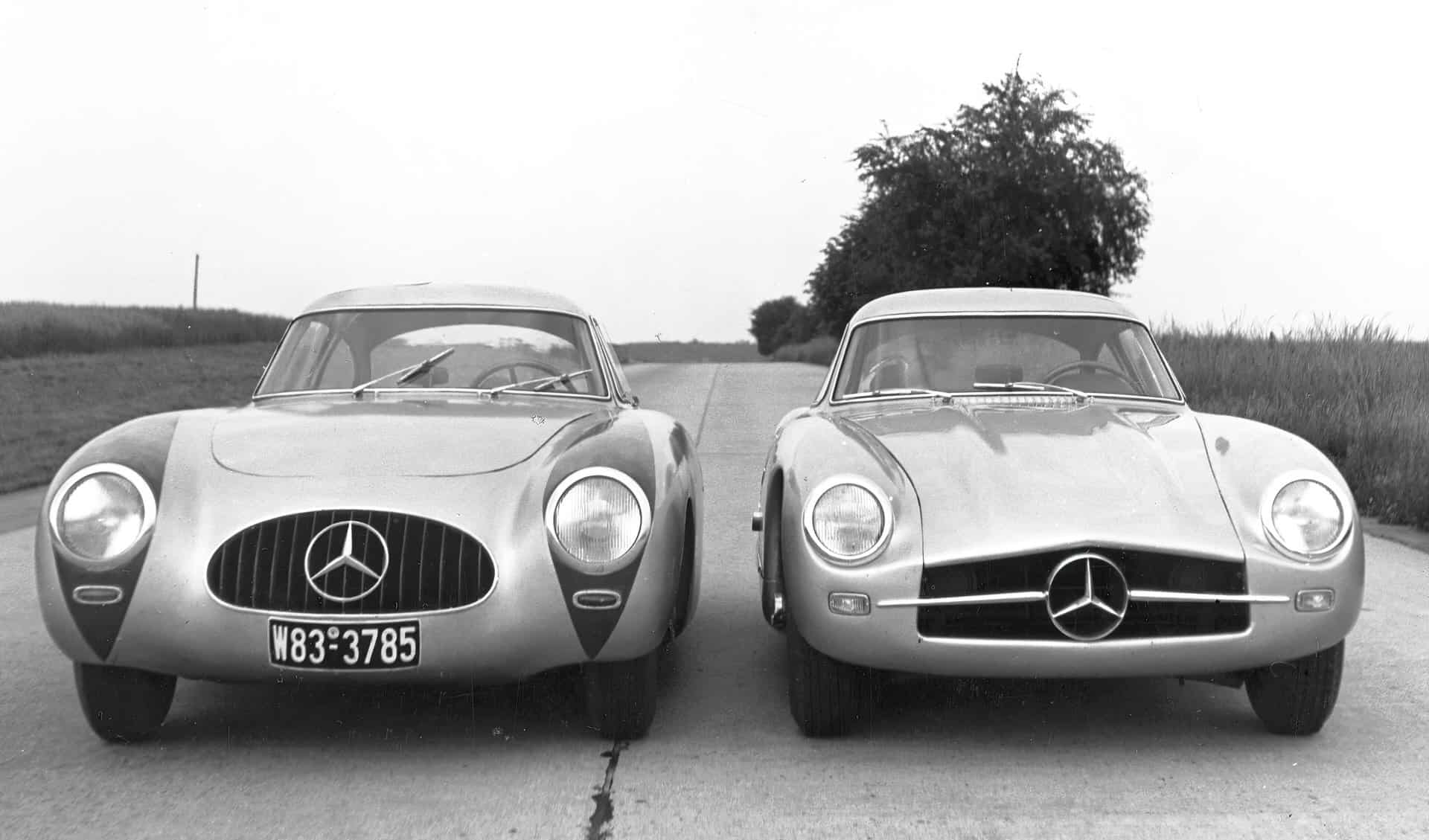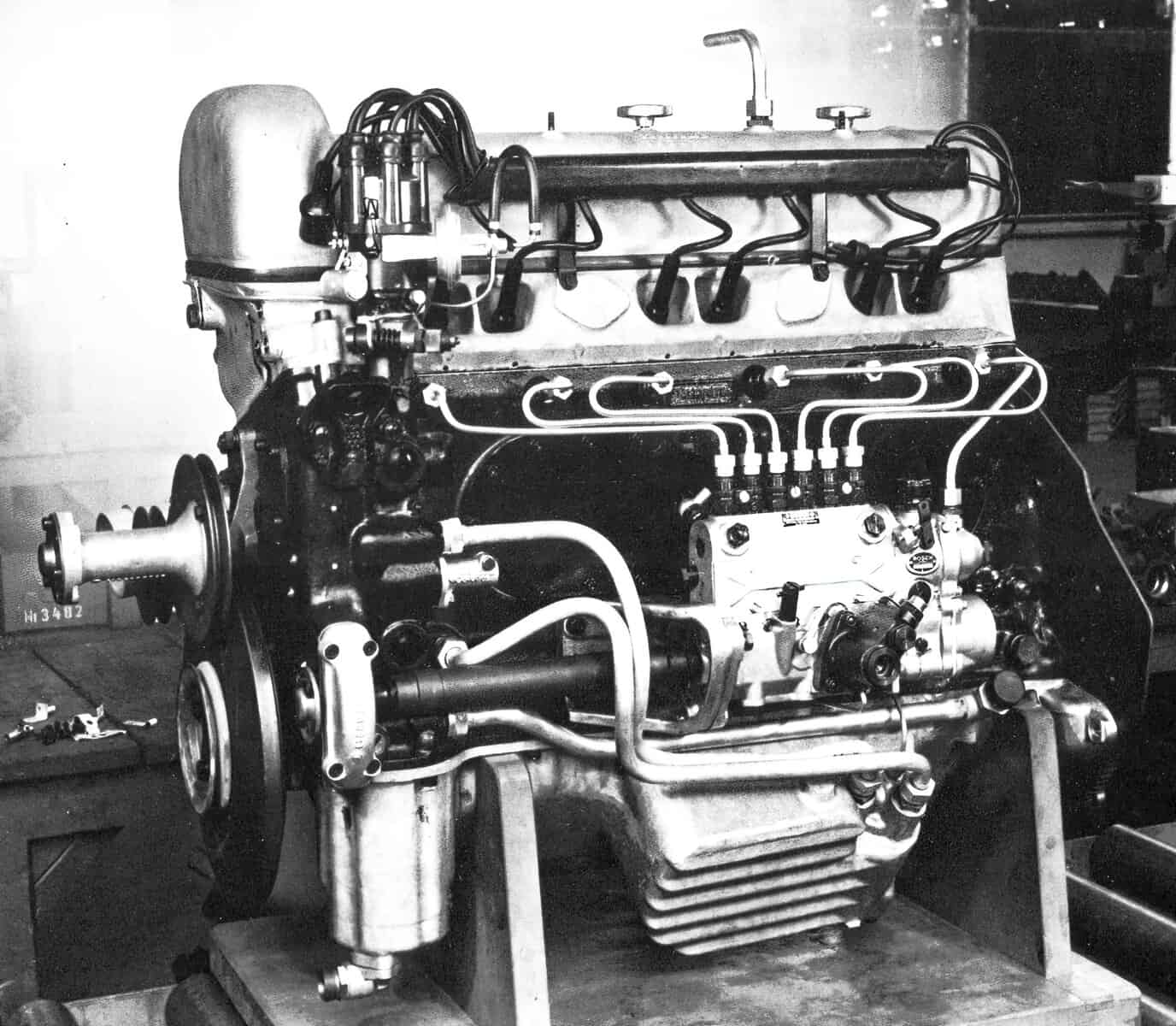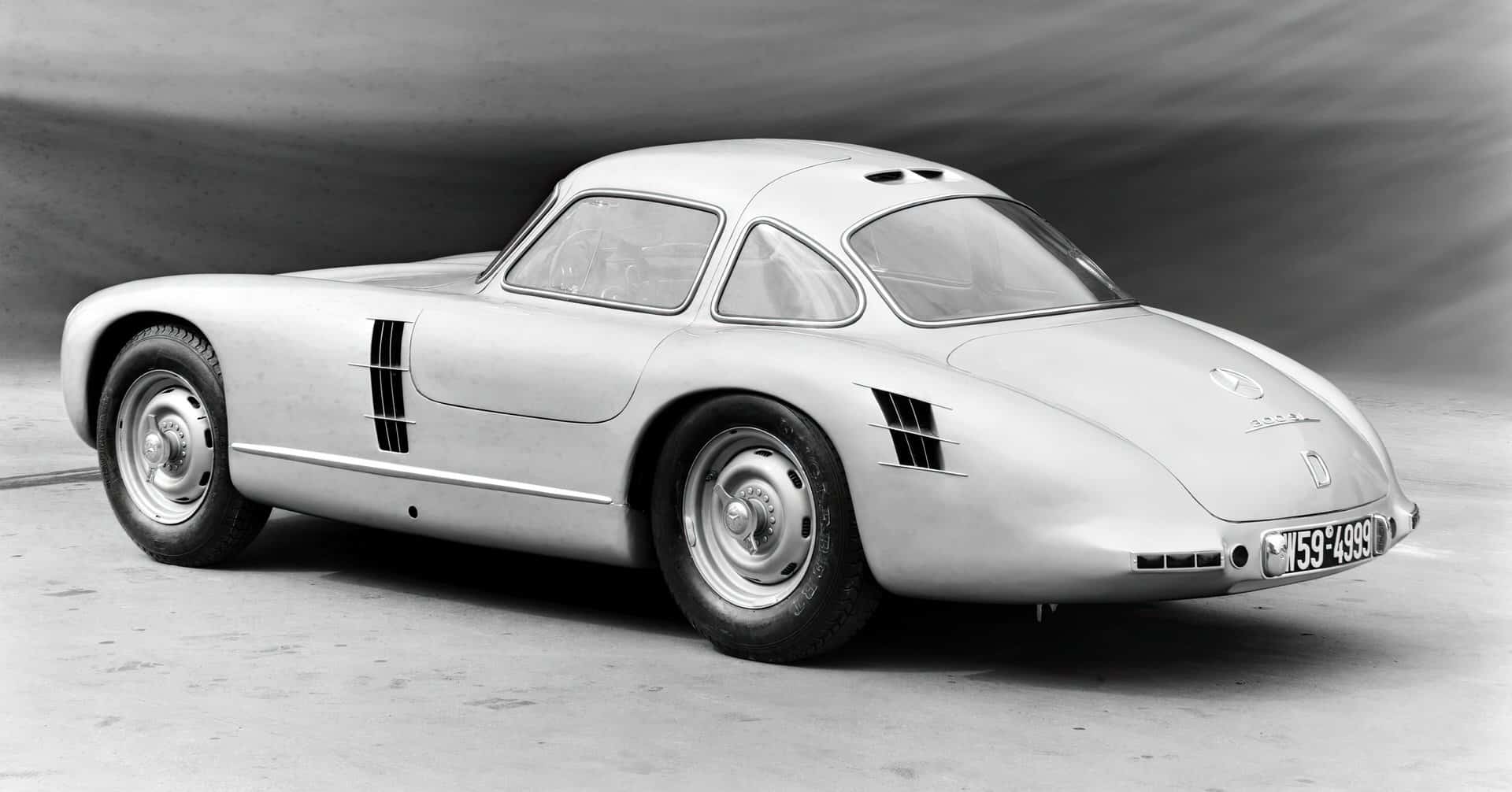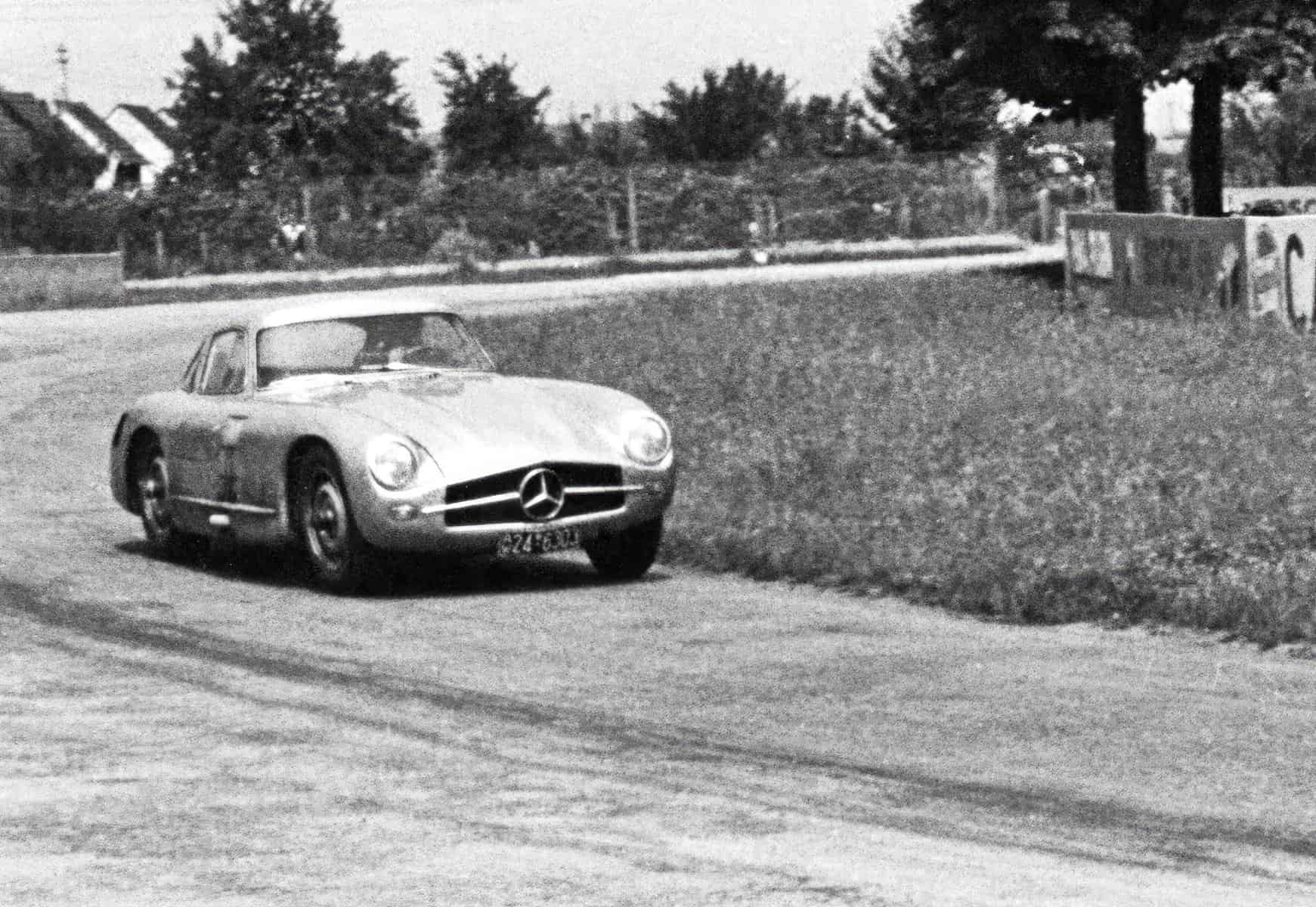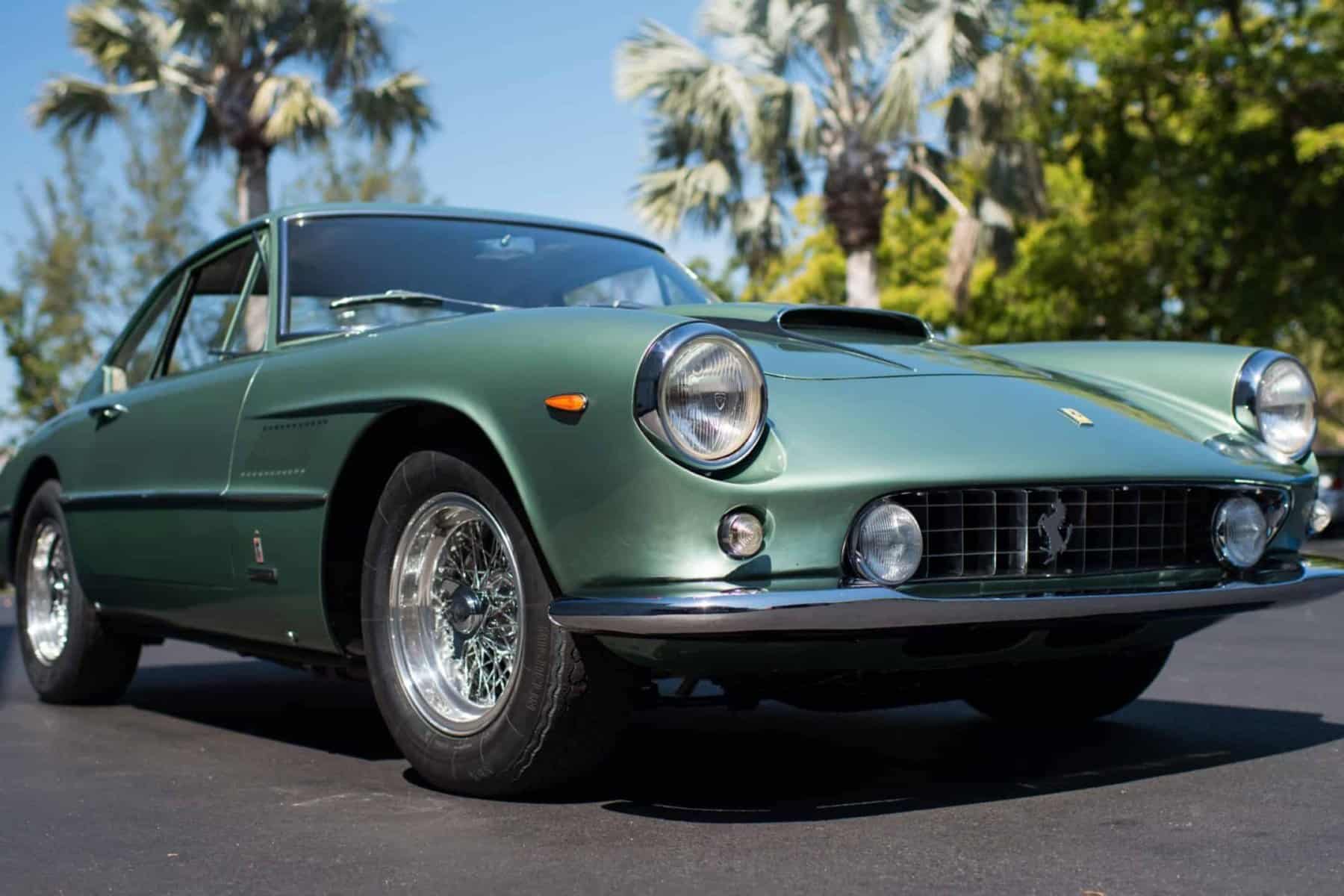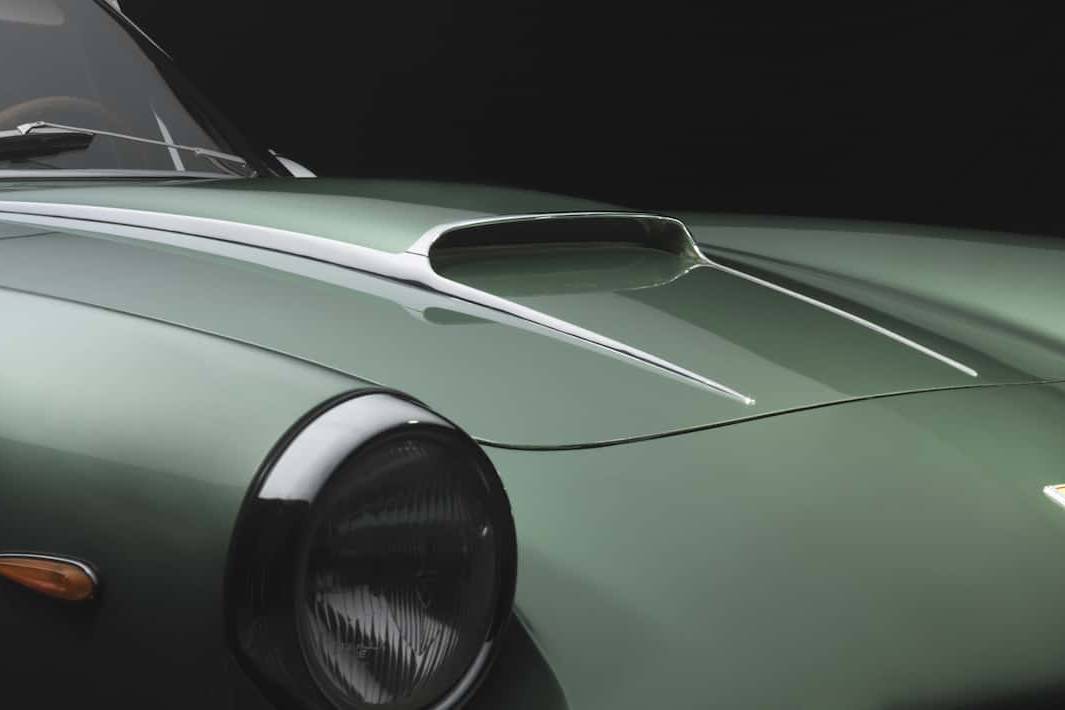Mercedes-Benz 300 SL/53
The first "Uhlenhaut Coupe"
WORDS & IMAGES BY: KARL LUDVIGSEN
Rudy Uhlenhaut set down the parameters for a faster racing sports car and Hans Herrmann proved that it worked. But the 1953-model 300 SL was caught in the hiatus between the 1952 season and the coming racers of 1954.
Looking ahead to its major re-entry to racing in 1954, Mercedes-Benz arranged a test and practice session on Monday, October 12, 1953. The venue was convenient, the Solitude circuit on the south-west side of Stuttgart. This was a twisting triangular course on public roads so 150 policemen had to be mustered to keep it clear.
Solitude would test both men and cars because its varied surfaces were in mediocre shape. The roads were narrow and uneven; a few months later improvements were to begin;. All the better to put the drivers to the test. Those present to drive were respected Karl Kling, Hermann Lang and Fritz Riess, the latter two the winners at Le Mans in 1952 in a 300 SL. Joining in was Rudolf Uhlenhaut, the head of Daimler-Benz research and development who on his day was as fast as any of them.
Also present was a 25-year-old Stuttgart café owner who had recently made a name for himself by becoming German Champion in the 1,500 cc sports-car class: Hans Herrmann. Race director Alfred Neubauer had signed him as a junior driver after tests conducted by Daimler-Benz at the Nürburgring that summer.
Two versions of the 300 SL were available for these tests and comparisons. One was an original racing coupe from 1952, chassis 08, while the other was chassis 11, which looked different. It was sharper-edged at the front with unusual air-exit vents and bulges in its hood. Under it was an engine equipped with fuel injection, the first Mercedes product to be so-equipped. It was a candidate to race in 1953.
So far no motorcar driver had managed to exceed or even reach the Solitude circuit’s “dream limit” of a five-minute lap. “As a comparison for our lap times,” said Herrmann, “we can have a look at the last race, which took place in 1950. Karl Kling achieved 5:11 in a Veritas racing car. The Australian Ken Kavanagh still held the motorcycle record since 1951 on the 500 cc Norton with 4:58.
“At the start and finish area at Glemseck there was a real racing atmosphere that morning,” Herrmann recalled. “Neubauer commanded his staff, company directors were there, engineers, Mrs. Kling, journalists, photographers, paramedics. All the equipment is laid out: tires, fuel barrels, signal flags, timing. The drivers took turns. The two cars completed many laps before mechanical damage occurred. As expected, we achieved the fastest times with the new Type 1953. The best laps were recorded as follows:
“Kling 5:17 minutes (track partially wet), Lang 5:10, Riess 5:07, Uhlenhaut 5:03, Herrmann 4:52. I still remember well how a mechanic held out the scoreboard with the best time. Alfred Neubauer later noted in his report: ‘The performance of our young driver Hans Herrmann surprised us again. He was the only one who went below the five-minute mark and broke Kavanagh’s official lap record.’”
This was an impressive result not only for Herrmann but also for the 1953 version of the 300 SL, represented by chassis 11. Also satisfied was Uhlenhaut, who not only set out the parameters for the 1953 300 SL but also directed the changes that made it much faster than the 1952 model. “The next day,” recalled an observer, “the newspapers were full of praise for the new car and the new Mercedes works driver.”
Little did they know that the 1953 Mercedes-Benz 300 SL, so impressive in looks and performance, was a dead duck and had been since January 21. That was the day on which engineering chief Fritz Nallinger wrote to Uhlenhaut, Neubauer and their close colleagues to state that racing participation would cease in 1953. Exciting new cars were being prepared for 1954. All emphasis would be placed on their design and perfection.
But the new record-holder at Solitude, chassis W 194/00011, escaped the implications of that ukase. At the time of Nallinger’s declaration it hadn’t been completed. The plans to make nine more like it, launched in November 1952, hit the barrier. But the prototype of the new 300 SL racing version would carry on.
One of the major advances in the new car’s six-cylinder 3.0-liter engine, adding much of its speed, was its use of fuel injection. Engine maven Heinz Lamm had already shown its potential by fitting Weber carburetors, giving each cylinder its own clear and smooth passage to its ports to aid the exploitation of inlet ram effect. Both power and torque numbers rose when three twin-throat Webers were feeding a revised cylinder head with larger inlet valves and ports. But Webers were not the ultimate answer.
Daimler-Benz played the same role in advancing fuel injection for automobiles that it had in introducing supercharging a generation earlier. Like supercharging, fuel injection came to Mercedes-Benz cars through racing after proving itself on aircraft engines in the course of a great world conflict. Also relevant was the company’s experience, with Bosch, in the development of direct-injection equipment for car and truck diesel engines.
Just how this was achieved is a subject that deserves a separate story. Engineers who contributed to the advancement of fuel injection at Daimler-Benz were Herbert Maruhn before the war and Hans Scherenberg afterward. The latter in fact was the first to productionize fuel injection on the two-stroke Goliath GP700 Sport and GP700 E models in 1952, before he moved to Daimler-Benz. He led the work on this advancement that ultimately spread across the Untertürkheim company’s range, with the invaluable help of Bosch.
As applied to the 1953 car’s M198 six, injection helped raise its power past the 200 mark to 220 bhp at 5,600 rpm and its torque to 202 lb-ft at 5,220 rpm. These figures corresponded to Rudy Uhlenhaut’s stated objective of a 21 percent increase in power for the 1953 model and a 7 percent rise in torque.
By exploiting the added power in a more compact and less heavy car with 16-inch wheels, lighter shock absorbers (a Rennabteilung obsession) and the initiation of disc-brake experiments with Britain’s Lockheed, Rudy Uhlenhaut stated, “I am convinced that a sports car of this design will have good chances for success in the year 1953.” This was on 1 December 1952, when plans were going forward robustly for the 1953 season.
The 1953 prototype, chassis number W 194/010000011/53, was built to incorporate as many of Uhlenhaut’s ideas as possible. The use of disc brakes went by the board for the time being, but better braking would be the result of larger brake drums made possible by the use of 16-inch wheels. The former 15-inch wheels had been a point of debate with racing-tire suppliers, who complained that they were too small to carry rubber that could have decent wear as well as grip capability. They now carried 8.25 x 16 tires on rims 7 inches wide.
Among the means urged by Uhlenhaut for lightening the 300 SL for 1953 were a body of magnesium, simpler and lighter fuel tanks and cast aluminum instead of cast iron for both the transmission housing and the cylinder block. Many of these were achieved in the first prototype. Moreover its lightness was aided by reducing the wheelbase to 90.6 inches, splitting the difference between the wheelbase of the standard racing coupe and that of the short roadster that had been built for the 1952 Nürburgring sports-car race.
The reduced wheelbase was also intended to shift more weight to the rear axle to improve drive traction. Planned to enhance this was a move of the battery and dry-sump oil reservoir to the rear. As well the four-speed transmission was moved to the rear of the chassis, where it was attached by a magnesium adaptor to the front of the differential. It was shifted by a remote-control rod going forward to the gear lever. This was a return to the rear transaxle that had been a feature of M-B Grand Prix cars from 1934 to 1939.
To reduce the jacking effect that was preventing the added power from being used effectively in turns, the prototype’s rear suspension was converted to a low-pivot configuration. Never happy with the rear-axle chatter experienced with the pre-war Grand Prix car’s suspension, Uhlenhaut had fitted a low-pivot swing axle to one of these cars in 1951 as an experiment leading toward the design of a then-planned new 1½-litre racer.
The tests he conducted at various circuits showed, Uhlenhaut recorded, “that a swing axle with a low-placed pivot and thereby a lower roll center as well as a longer effective swing length, and with radius rods to transmit the propulsion forces from the driving wheels, produces very good handling characteristics which are at least equal to those of the double-joint axle [the normal W154 rear suspension] and evidently even superior. A swing axle that meets these requirements can be realized, using the existing axle housing with relatively few changes.”
Rudy Uhlenhaut added, “I believe that without lowering the roll center of the swing axle and without longitudinal support of the drive wheels the 300 SL will not be able to achieve a significant increase in performance on winding roads even if the engine output is far greater than at present.”
In addition to Uhlenhaut, Hans Scherenberg and Josef Müller shared credits in the patents covering the principle first implemented on chassis number 11. Swing arms to its rear hubs were pivoted to the bottom of the distance piece that joined the transmission to the differential. They swung in front of the exposed half-shafts. This gave a lower roll center.
Hub thrust and torque loadings were taken by a Watts linkage made up of radius rods above and below each hub. The lower rod ran forward and the higher one rearward, so that the rods would be in tension under braking torques. Coil springing was retained. This was in essence the rear suspension that would be used on the coming 1954-55 Grand Prix cars and 300 SLR sports-racers.
Chassis 11 was given the narrower track dimensions of 51.2 inches in front and 53.0 inches at the rear, a substantial reduction thanks to the new suspension. This was in aid of a decrease in frontal area, for which an 8 percent lower figure was sought to reduce drag.
Changes in the body of the 300 SL for 1953 were encouraged by wind-tunnel tests. They showed that the original system for ducting the escaping radiator air increased the drag coefficient (Cd) by a startling 20 percent. Allowing the warm air to depart instead through vents at the sides of the engine room, into a low-pressure area, incurred a rise of only 5 percent in the Cd. Karl Kling’s Le Mans/Mexico coupe was modified experimentally to this form of venting.
Like the 1952 300 SL and yet subtly different, the body shape of the 1953 car was most changed at the front. It had a wider rectangular air intake with a bold three-pointed star at the center of a horizontal bar. The hood was sharply downswept between the fenders and the smaller, lighter headlamps. For the first time this required two “power bulges” in the hood panel—one over the cam cover and the other over the inlet plenum chamber.
In accord with the wind-tunnel findings, vertical vents at the sides of the cowl were added to exhaust the under-hood air, the exhaust pipe peeping from the bottom of the right-hand vent. Other vents were added in the rear fenders. A new grille at the base of the windscreen drew in air for cockpit ventilation and the air outlet at the rear of the roof was made permanently open instead of the flip-up door it had been in 1952. An external fuel-filler was set into the right side of the plexiglass rear window. Tail lamps were mounted in relief from the main body shape.
Instead of the hoped-for magnesium, aluminum was used for the body of the 1953 prototype. An aggressive-looking car, its sloping hood attracted the nickname Hobel at the works after the sharp-nosed planes or scrapers that are used to finish rough bodywork. Newly designed, its handsome cockpit had a single shroud over both the speedometer and tachometer and a high central tunnel to contain the rear transaxle and its remote shift linkage.
Plans for the modified bodywork of the W194/11 came from coachwork designer Walter Gragert, who before the war worked for the renowned Dresden coachbuilding company Gläser. He now reported to Walter Häcker at Sindelfingen, where bodies for nine more cars would be made. The prototype was created at the racing department in Untertürkheim, where Walter Schüller was responsible. Hans Scherenberg called Schüller “an artist of God-given talent” in recognition of his extraordinary skill in forming and working metal panels of all kinds.
Perfection of the revolutionary induction system paralleled that of the rest of the car. This 1953 prototype received intake air through a fabricated aluminum manifold with individual ram pipes leading to each inlet port from a long cylindrical plenum chamber. Air entered the front of this chamber, under the control of a large throttle valve, from a scoop behind the grille. Inserted between the inlet and exhaust manifolds, a polished aluminum sheet kept the inlet pipes from becoming too hot, which would reduce the density of the ingested air and subsequently the power of the engine.
In his December 1 manifesto for the 1953 car Uhlenhaut was looking for a weight reduction on the order of 155 pounds. In spite of the lack of either the magnesium body or the aluminum cylinder block, this was nearly achieved. Chassis 11 was compared with chassis 8, Kling’s Carrera coupe, both with two spare wheels and 150 litres of fuel aboard. Against the 1952 car’s 2,591 pounds the new one scaled 2,450 pounds—a 141-pound reduction.
In fact engines with aluminum blocks were used at times—as new historical evidence reveals: the experimental aluminum engines M 198/81 and 198/82 were used in test sessions at Hockenheim and at the Solitude circuit in 1953 and 1954.
The idea of racing this new version of the 300 SL (with its shorter wheelbase the 300 SLK?) was still very much alive. The necessary works commissions were put in hand. Fritz Nallinger approved the construction of ten new cars, in addition to the prototype. Its dedicates space frame was completed on December 18, 1952. After building the first body of the final shape itself, the Racing Department was to ship its wood model to Sindelfingen not later than 15 February 1953 so that four more bodies could be made there between March 7 and April 7to have five cars ready in good time for the Mille Miglia on April 25th.
In the meantime preliminary experimental work was progressing at Untertürkheim through 1952 on the concept of a new Grand Prix car for the 1954 season. Promising solutions, such as the use of fuel injection and the low-pivot swing axle, had been found to the challenges posed by the new 2½-liter G.P. formula.
Early in 1953 Daimler-Benz senior managers were ready to commit their company to the huge challenge of a Grand Prix campaign in 1954. All its resources were needed, it decided, to make this the success it had to be. As well, the program included a sports car based on the G.P. concept. Thus the decision was taken to scrub the ‘300 SLK’ project. Only the prototype, chassis 11, remained to suggest what might have been.
Nevertheless the unique sports coupe served its purpose. Ready to rumble in the spring of 1953, it was driven in public by members of the test and racing departments. It was Rudy Uhlenhaut’s favored transport until his 300 SLR coupes were ready. In fact this car fully deserves the designation “Uhlenhaut Coupe”, for it was Uhlenhaut who specified the design that was subsequently built according to his concepts and ideas.
Used for regular test drives in the Alps or for travel to the Geneva Motor Show, the Hobel also carried out intensive tire-testing and driver-training assignments. In November 1953 it was featured on the cover of ADAC Motorwelt, the house organ of Germany’s biggest motoring association. A month earlier the magazine Auto Motor und Sport had published official works photos under the heading “SL 1954”.
Modifications of the car’s exterior were made over the years, sometimes leading to the belief that there were several examples of the 300 SL/53. One change was in its exterior. During 1955 the car was given dark-grey paintwork and the radiator aperture was accentuated with chrome and aluminum trim. Why this was done is not apparent from the records. As well the air vents behind the rear wheels were given four horizontal chrome louvres instead of the original three.
On July 3, 1953 tests were scheduled at Hockenheim to measure tire wear and test a recirculating-ball steering system. The engine with an aluminum cylinder block was used and a 3.25:1 rear-axle ratio was installed. Test laps were driven by Rudy Uhlenhaut and his assistant Walter Kostelezky. The 300 SL/53 proved to be decisively faster than its sister from 1952: Uhlenhaut’s fastest lap time of 2:31.7 with the old racing 300 SL was lowered to 2:20.1 with the 300 SL/53.
The enormous time reduction of 11.6 seconds impressively demonstrated the correctness of Uhlenhaut’s theories on how to make the 300 SL a winning proposition for 1953. On the long straight between the East Bend and the Friedhof Bend a maximum engine speed of 6,100 rpm was achieved with the new car, though only 5,800-5,900 rpm was possible in the old car with the same final-drive ratio.
Juan Manuel Fangio, whom Alfred Neubauer was persuading—so far vainly—to accept a seat on his 1954 Grand Prix team, was offered the wheel of the prototype coupe at Monza during tire tests at the fabled Italian circuit on September 30 and October 1. He lapped at 110.61 mph. This was quick but below the speeds of some 113 mph recorded the previous June by the latest 3.0-liter Ferraris and Lancias at the same track. The decision not to race the new-type 300 SL in 1953 seemed vindicated…although the new car had neither its planned weight-saving aluminum cylinder block nor its magnesium body.
Nonetheless the Monza tests further validated how much faster the new car was. In particular they showed how well the changes suited the new car to the virtuosity of a driver of the caliber of Fangio. Lap-time comparisons with a 1952 coupe at Monza told the story.
Driver 1953 300 SL 1952 300 SL
Fangio 2:7.5 2:15
Herrmann 2:9.0 2:14.5
Lang 2:9.5 2:14
Kling 2:9.5 2:14
Riess 2:9.5 2:14.5
Uhlenhaut 2:10.5 2:15.5
The last word went to Hans Herrmann. He described the unique car’s driving behavior and road holding as “very good, with slightly oversteering cornering behavior. The suspension was harder than on the production model but less hard than on the 1955 racing 300 SLR.” As for the oversteering, this would be dealt with by the low-pivot swing axle used in the 300 SL Roadster. In the Daimler-Benz of those days—and even today for that matter—no hard-learned knowledge goes unexploited.
